In order to run an online business profitably, choosing a suitable shopping cart solution is extremely essential. Among the most well-known shopping cart solutions, PrestaShop vs Magento are two of the most prominent names. Thus, it could be challenging to determine a better platform between these two.
For this reason, LitExtension – #1 eCommerce Migration Service is here to help you make the decision easier. In this article, we will go through the following key points:
- An overview of PrestaShop and Magento
- Detailed comparison of all aspects of PrestaShop vs Magento
- Deciding which platform is the best for your store
Keep scrolling for more!
PrestaShop vs Magento: Overview
What is PrestaShop?
Being one of the ideal Magento alternatives, PrestaShop is a feature-rich open-source eCommerce solution. Despite being an open-source platform, PrestaShop is fairly easy and convenient to use. There are currently over 220,000 websites that are running on PrestaShop (Source: BuiltWith).

Want to move your current store to PrestaShop to make use of its advantages? Don’t miss the following articles because we’ve covered detailed migration guides for you:
What is Magento?
Magento (Adobe Commerce) stands out as one of the leading open-source platforms on the market. Up to the present, it is the home of over 130,000 live websites (Source: BuiltWith). As an open-source platform, Adobe Magento 2 facilitates customization and extension development, empowering enterprises to craft distinctive and personalized eCommerce experiences for their clientele.

Additionally, this platform is outstanding in customizability. Moreover, Magento 2 also has a wide range of apps and extensions.
PrestaShop vs Magento: Pros & cons
[wptb id=70969]
PrestaShop vs Magento: Detailed Comparison
As you can see from the previous section, both PrestaShop and Magento have their own pros and cons, making it even more difficult for us to choose. But worry less because we have done all the hard work for you.
From our experience of working with a wide range of eCommerce platforms, we have gained some valuable insights into PrestaShop vs Magento. Before digging deeper, please take a look at our quick comparison table below.
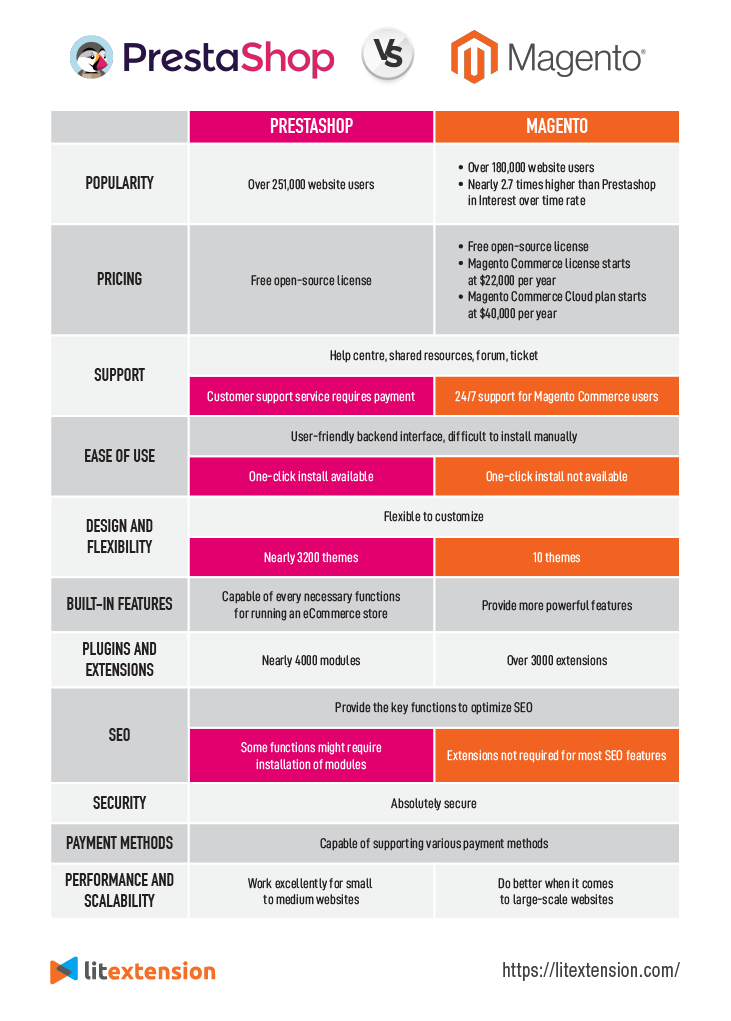
1. Pricing
Magento pricing
Being an open-source solution, Magento does not necessitate a monthly subscription. This platform is available for free download, installation, and store setup. However, during the construction of our Magento store recently, we learned that securing a domain and selecting a hosting provider are prerequisites for website publication. Hence, the cost of Magento varies depending on your choices.
Moreover, if you aim to enhance your store’s functionalities, you can explore additional integrations by installing apps from the Magento App Market. The maximum costs for this could range anywhere up to $15,000.
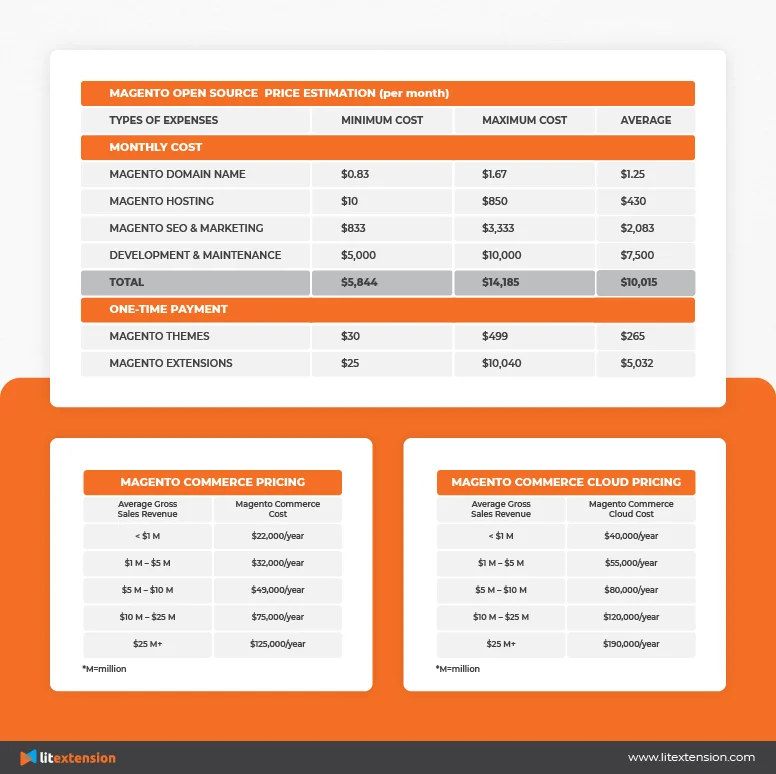
PrestaShop pricing
- The PrestaShop edition: As an open-source platform, PrestaShop is free to set up.
- Hosting of PrestaShop: There is no hosted edition available for PrestaShop. Therefore, you can use the hosting plans listed above, such as SiteGround, Bluehost, or HostPapa.
- PrestaShop themes: PrestaShop themes pricing starts from $70 to $350.
- PrestaShop add-ons: Equivalent to Magento extensions, there are many freely available PrestaShop add-ons. The paid-for add-ons price starts at $35 to $5800.
The Verdict
For small to medium stores, the cost of operating on PrestaShop vs Magento is not significantly different. However, the major distinction between the two platforms regarding price appears when it comes to large-scale businesses. In this case, Magento provides more pricey solutions.
2. Ease of Use
Magento ease of use
Although the Magento interface is a quick and easy self-hosting setup, it is still classified as expert level as it requires technical knowledge during the process. You need to set up FTP and transfer Magento Archive to your hosted system to install, which can take you a lot of time and effort. Therefore, Magento users might need consultation from developers or experts to develop their site.
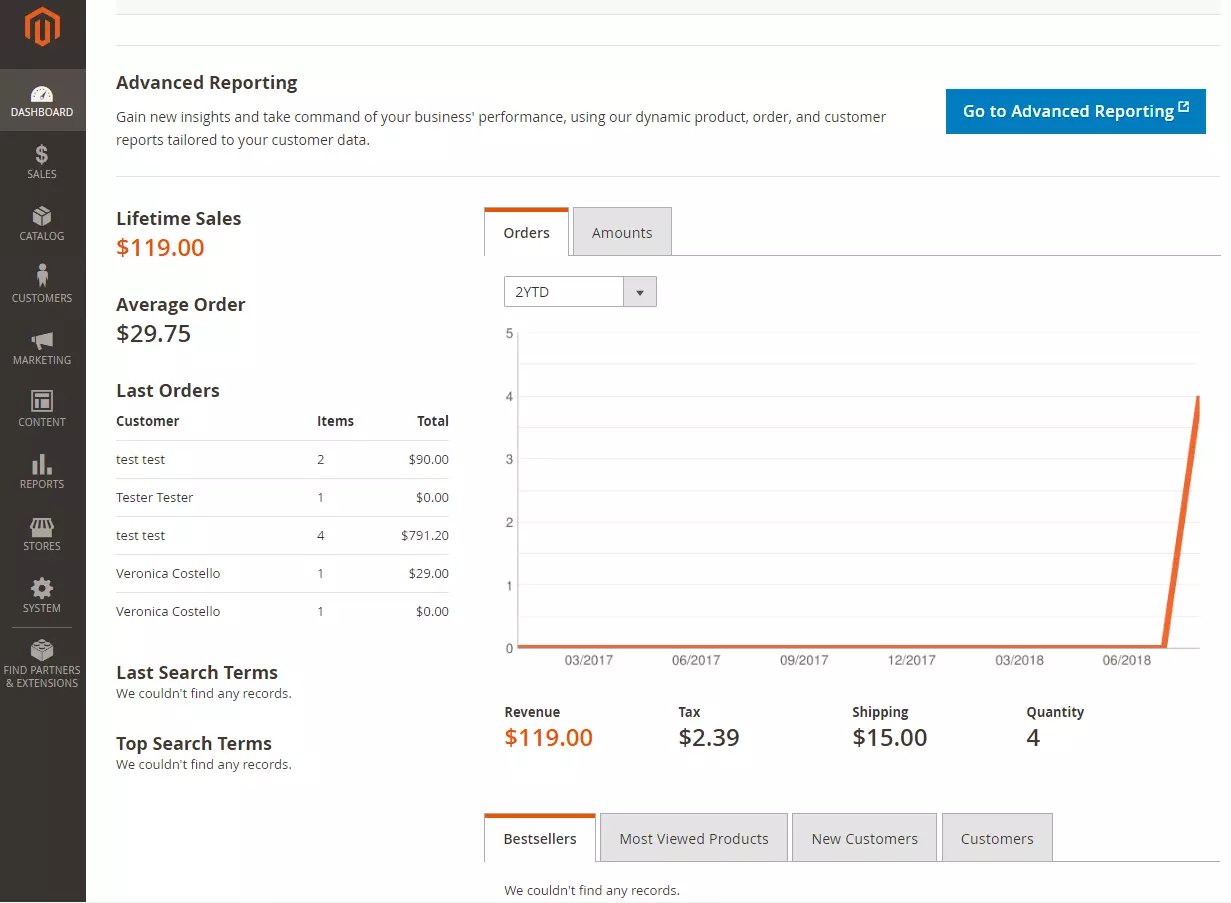
Prestashop ease of use
Both the front-end and back-end interfaces of PrestaShop are both intuitive. Compared to Magento, PrestaShop offers a more simple and time-saving method to install and set up a store called the one-click installation script.
After that, when your site is up and running, daily operations are fairly simple. From order, product description, categories, quantities, SEO features, etc., you can quickly find those actions on the dashboard.
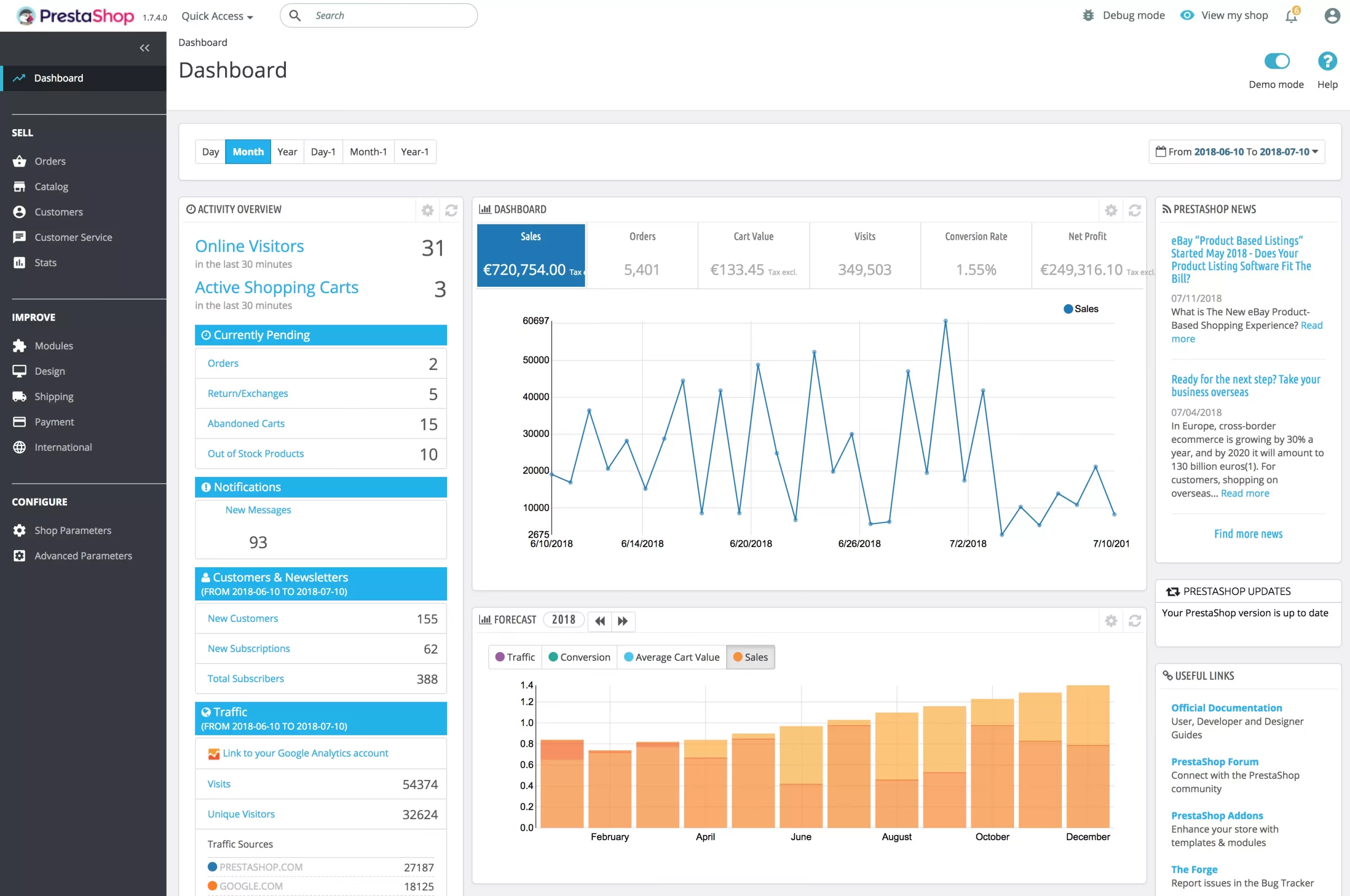
Moreover, the PrestaShop admin panel can also be accessed via mobile devices like smartphones or tablets.
The Verdict
From our experience, we highly prefer PrestaShop over Magento in terms of ease of use. While PrestaShop scores 4.1/5, Magento has a much lower score of 3.6/5. If you’re looking for a more easy-to-use eCommerce platform, migrating your store from Magento to PrestaShop should be considered.
3. Themes & Flexibility
Magento themes
Store owners of the two platforms can select ready-made themes on the marketplace. For Magento, there are 11 themes available on its marketplace. Find out the most suitable theme for your Magento 2 store in the collection of best Magento themes by LitExtension.
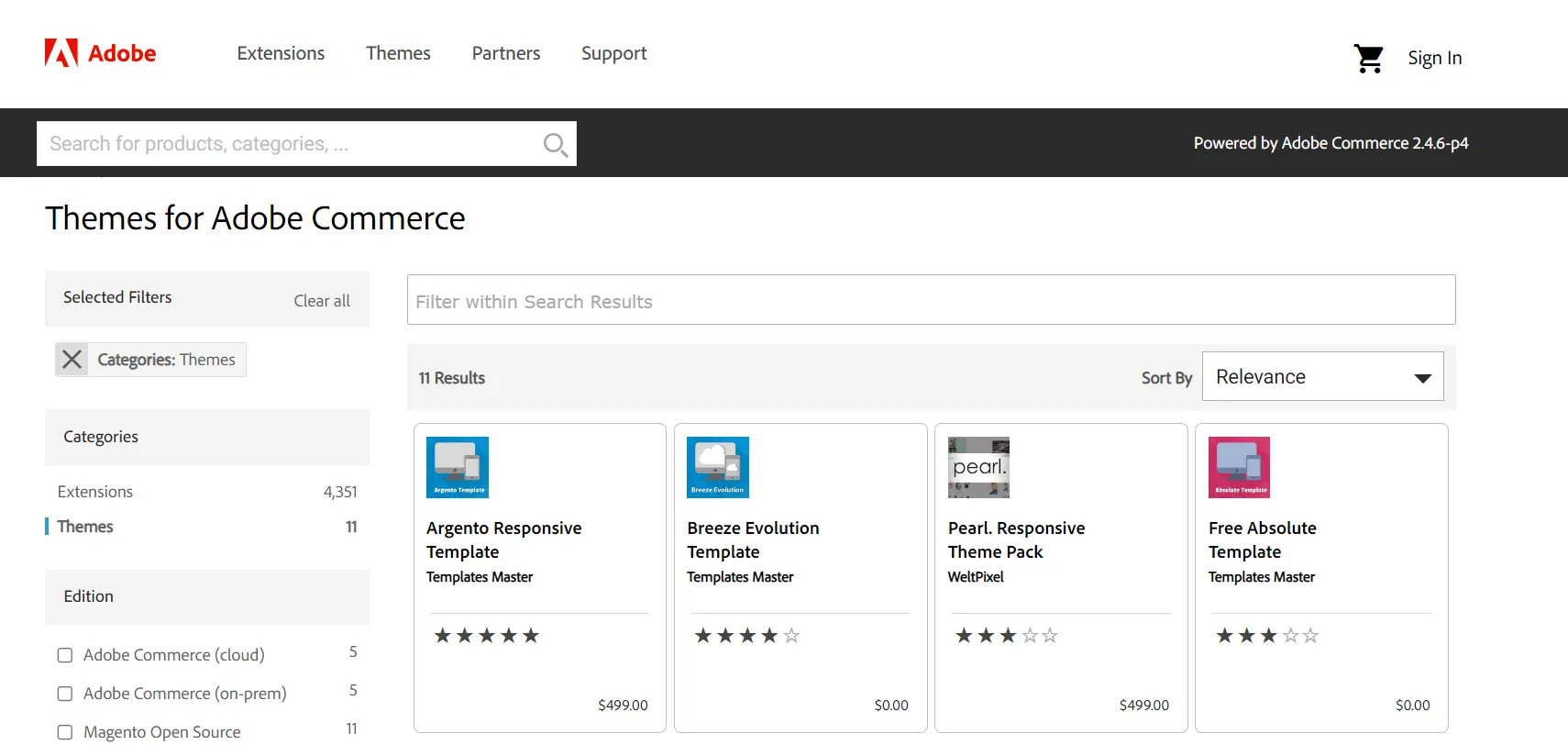
PrestaShop themes
At the same time, PrestaShop provides a massive number of nearly 1700 ready-made templates for its users. Moreover, PrestaShop themes are sorted into 15 categories: Food & Restaurant, Home & Garden, and Health & Beauty.
You can also sort them according to your store’s current version. PrestaShop clearly leaves no one left behind.

Besides the themes provided on the marketplace of the platforms, customers can also purchase themes from third-party providers such as themeforest.net. Don’t forget to refer to the best PrestaShop themes you shouldn’t miss.
The Verdict
Since both platforms are open-source, merchants can flexibly modify the pre-made themes according to their brand identity or build a fully customized website design from scratch. However, it is clear that PrestaShop significantly outweighs Magento when it comes to the number of themes.
4. Built-in Features
Magento built-in features
Magento is a comprehensive solution for eCommerce, as all of the necessary features are available. Its built-in features are on the next level, which is also what we love most about this platform.

However, it is important to note that the Magento Open-source edition is more limited than the Magento Commerce edition. Many features available in the Magento Commerce edition, such as multiple languages and currencies, might require users to install extensions to activate the free, open-source edition of this platform. You can find out more exclusive features of Magento Commerce here.
Indeed, Magento Commerce ensures first-class eCommerce built-in features. Besides the basic ones, it also provides highlighted features:
- Customer segmentation and presentation. This feature allows users to create personalized shopping experiences for their customers based on their properties, such as age, gender, location, or behavior.
- Dynamic rule-based product relations. Store owners can set automated rules to determine which products to present as up-sells, cross-sells, and related products to each customer segment.
- Elastic search. This feature ensures that websites can handle large catalogs and easily scale search capacity. It offers suggestions for customer misspellings, support for stop words and attribute weighting, and synonym management to increase relevancy and conversions.
PrestaShop built-in features
Similarly, PrestaShop is also capable of every necessary function for running an eCommerce store, such as creating and managing products, creating special offers, multi-currency, multi-language, and reducing abandoned carts.
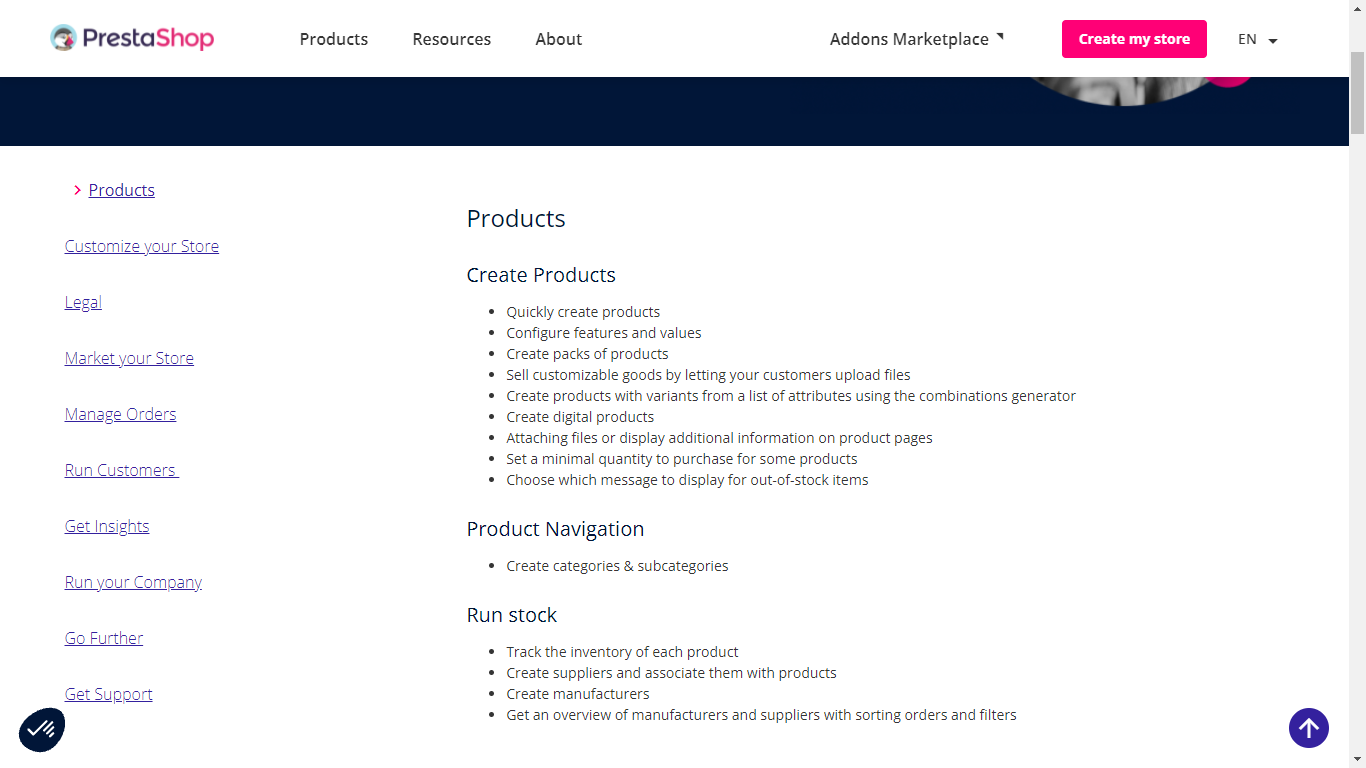
Besides, PrestaShop also has features that allow customers to get insight into their business performance, including marketing performance (in-site visitor data, traffic, etc), product, sales, and customers. Additionally, the platform also generates forecasts based on these data.
The Verdict
Both PrestaShop and Magento provide all the crucial eCommerce features, but the Magento Commerce edition would offer more diverse and advanced features.
5. Extensions & Modules
Magento extensions
There are over 4,000 extensions available on the Magento marketplace. Over a third of them fall into the Content & Customizations category, and the rest serve other purposes of Sales, Payment & Security, Shipment & Fulfillment, Site Optimization, etc.
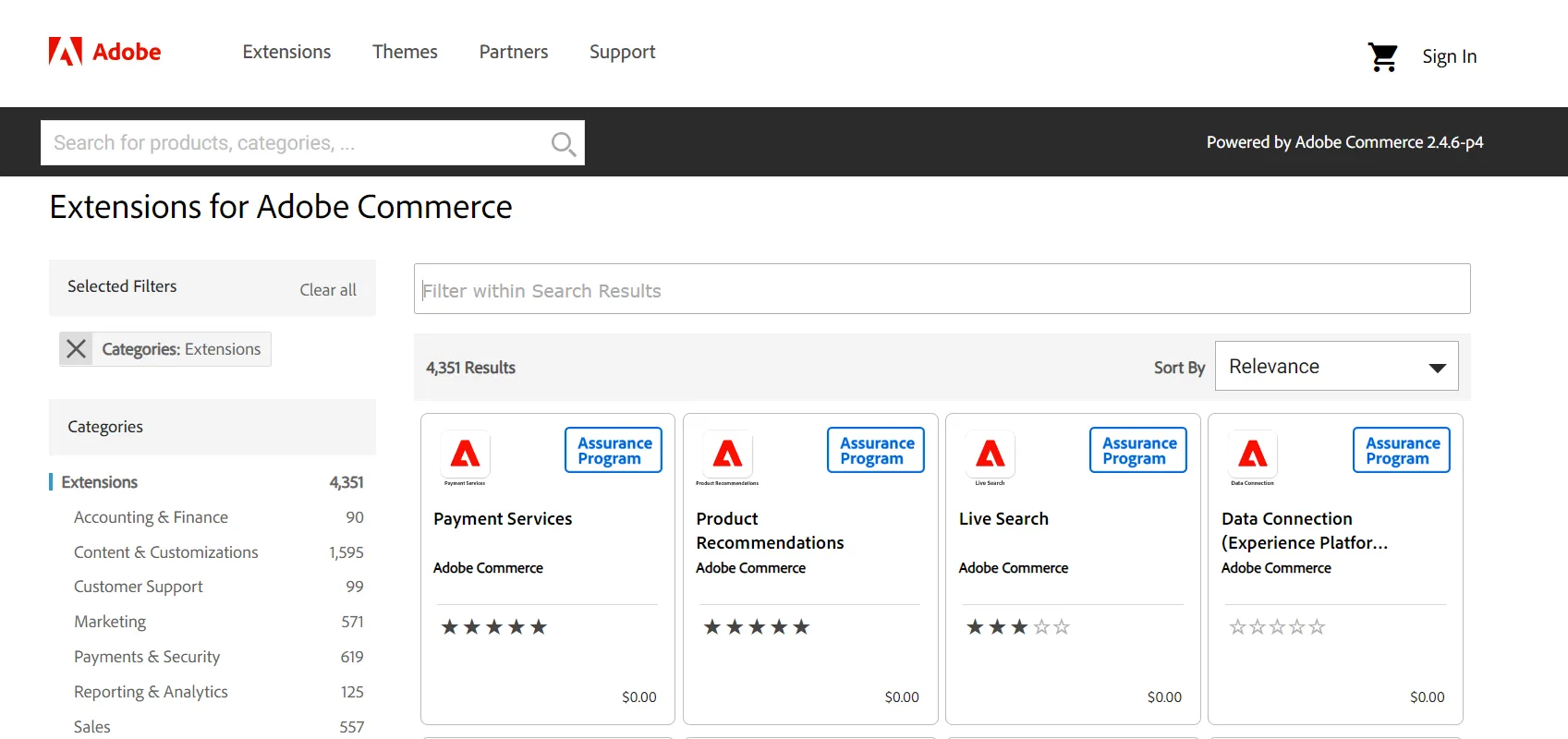
Bonus reading: Top 7 must-have Magento extensions for your store.
PrestaShop extensions
PrestaShop provides access to an extensive collection of approximately 4000 modules, which can be effortlessly incorporated with just a few clicks. These feature-rich modules are instrumental in enhancing your store performance and are particularly advantageous for beginners.

The Verdict
It’s a tie for the competition between PrestaShop vs Magento extensions in both terms of quantity and quality. These add-ons are sorted not only by categories but also by purposes such as traffic, conversion rate, or customer relations.
6. Marketing & SEO
Magento SEO
Magento comes with built-in SEO capabilities, offering a robust set of tools designed to enhance search engine rankings. Its default functionalities are comprehensive and effective, aiding in improving visibility online. Furthermore, Magento 2 SEO provides features for handling promotions, communication, and content management.
Meanwhile, adding to the list of built-in features, the Magento Commerce edition also provides other advanced marketing tools such as customer segmentation and targeting, as discussed above, or analytics and report generator.
PrestaShop SEO
If most of Magento’s SEO practices are built-in, then you will have to install modules when building your website on PrestaShop. You can choose from 170+ SEO and marketing add-ons offered in the PrestaShop store.
In terms of marketing and promotions, PrestaShop can be described as “robust”. Through collaborations with major players such as Google, Facebook, and Klaviyo, PrestaShop significantly simplifies merchants’ marketing endeavors.
The Verdict
Both of these eCommerce platforms offer an extensive array of features aimed at optimizing SEO. Capabilities like URL adjustments, canonical tags, and implementation of 301 redirects are all fully supported.
7. Security
Magento security
In the case of Magento, the platform fixes its security vulnerability every 10 to 15 days using Magento security patches. The Open-source edition of Magento offers a Content Security Policy, which is a structured collection of guidelines that can set bounds for the content of browsers such that only whitelisted services appear.
As a result, this lets the browser decide which web tools should be blocked and which can be trusted. You can also utilize third-party security tools to ensure the secure state of your store.
Besides, the Magento Commerce edition makes PCI compliance easier by offering integrated payment gateways where credit card data is passed directly from the consumer’s browser to the payment gateway.
There are also many security extensions available for users. One example is the Security Suite extension provided by Amasty, which highlighted features including:
- Protect your store from spam and bots;
- Get the full picture of all admin actions;
- Receive notifications about all suspicious login activities;
- Double your store security with two-step authentication;
- Effectively manage user permissions.
In addition, any merchants using Magento Commerce (Cloud) can use Magento’s PCI Attestation of Compliance to aid their own PCI certification process. Furthermore, Magento Commerce Cloud is a virtual private cloud that only allows a secure connection.
PrestaShop security
For PrestaShop, its downloadable set-up file is PCI compliant. Payment Card Industry Data Security Standard (CPI DSS) is a data security standard with which every company that accepts card payments needs to comply.
Furthermore, there are numerous PrestaShop security modules that store owners can install. For example, the Official GDPR Compliance ensures your store compliance with the General Data Protection Regulation law, which is a regulation in EU law on data protection and privacy.
Another example is the Security Lite module which reduces the risk of unauthorized access by adding another layer of security to your PrestaShop website. The features of this module include:
- Brute force protection;
- Analyze HTTP headers;
- Block custom list of IP addresses;
- Block custom list of user agents;
- Ban IP’s;
- Automatic backup database;
- Generate strong passwords;
- Fix insecure permissions;
- Remove malicious files;
- Disable right-click;
- Disable right-click for images only;
- Check your shop for all known vulnerabilities.
The verdict
All in all, PrestaShop vs Magento are absolutely secure platforms to work with. But it also depends on you installing security extensions to protect your website.
8. Payment Methods
Magento payment methods
In terms of third-party service providers, Magento is currently supporting PayPal, Klarna, and Amazon Pay. Users can add other payment gateways via payment extensions.
Also, Magento default payment methods include:
- Check/money order;
- Bank Transfer;
- Cash on delivery;
- Purchase Order;
- Zero Subtotal Checkout.
PrestaShop payment methods
By default, PrestaShop allows many payment methods, such as checks, cash on delivery, bank wire, and PayPal. Nevertheless, users can install other payment gateways using PrestaShop modules such as the PrestaShop Checkout solution.
The verdict
Accordingly, PrestaShop vs Magento is capable of supporting various payment methods. This way, you can reach more potential customers and bring back satisfaction when shopping at your store.
9. Performance & Scalability
One of the most significant problems that hinder your store growth is slow loading times, lags, and errors happening when your websites have remarkably large amounts of traffic that exceed the regular amount of traffic for that site.
To be able to scale up, your eCommerce platform needs the capability of smoothly coping with this sudden rise in the number of visitors. In comparison between Prestashop vs Magento, performance and scalability are also key elements.
Magento performance and scalability
Magento has been one of the best eCommerce platforms for large and growing merchants and enterprises. As discussed above, Magento is a powerful platform that is capable of comfortably coping with up to 50,000 visits per hour.
Indeed, Magento has made client-side, server-side, and database improvements in order to meet the stability and scalability needs of large enterprises.
For example, Magento provides a number of optimizations that reduce the amount of data that must be passed to the browser in order to render the webpage, which reduces page weight and improves response time. Besides, the platform also improves server response time by integrating with Varnish page caching.
PrestaShop performance and scalability
On the other hand, the ability to handle large websites of PrestaShop is also exceptional, but it still could not surpass Magento. One of the largest websites on PrestaShop is botland.com.pl which is the biggest Polish online store for robotics and electronics specialists.
The comparison between botland.com.pl and christianlouboutin.com shows that the total visits to christianlouboutin.com (on Magento) are nearly 1.5 times as much as that of botland.com.pl (on PrestaShop).
The Verdict
Magento is doing better in terms of scalability when it comes to huge sites like international brands’ websites, but SMEs would not face any problems regarding performance and scalability on both platforms because PrestaShop would also work excellently for their websites.
10. Support
Since both PrestaShop vs Magento are open-source platforms, users must seek the answers to their queries on the help center, knowledge base, shared documentation, and resources of the platforms. Users of the two platforms can also support each other’s concerns on forums as well as seek the help of staff in these communities.
Magento support
Currently, there are over 460,000 members on the Magento forum. Apart from the forum, we can submit queries via ticket to the platforms for more advanced questions.
Especially, Magento Commerce users receive much more active customer support than the Open-source plan. To be more specific, while Open-source plan users have to look for solutions themselves, customers of the Commerce edition can reach Magento Enterprise Edition Customer Support via online portals and telephone.
Besides, technical support from a real person is available 24/7. Moreover, you can also pay an extra fee to be supported by Magento Expert Consulting Group.
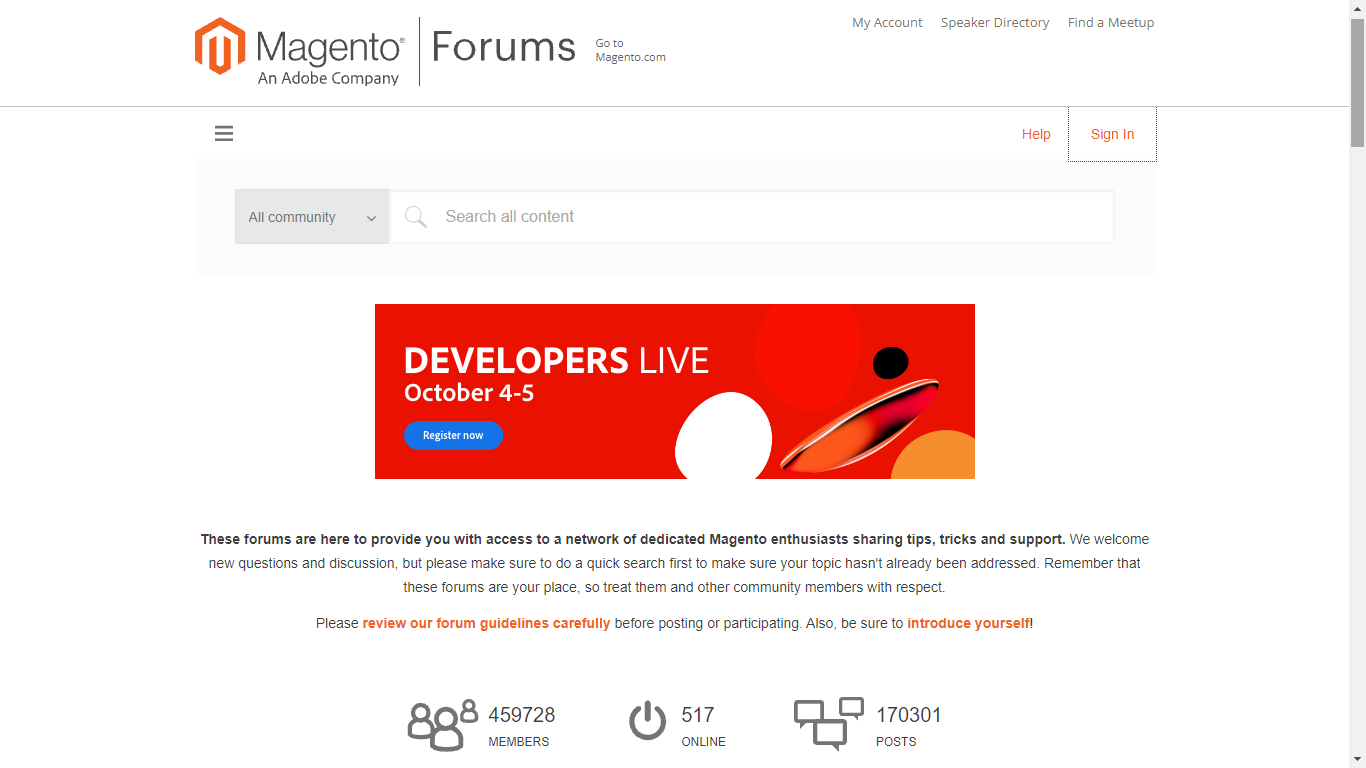
PrestaShop suppport
On the other hand, the number of members on the PrestaShop forum is over 1,292,000, which is nearly three times higher than its competitor.
It also provides customer support services that require payment. One example is the “PrestaShop Support Plan,” which includes speedy customer support and expert consultancy. This service would cost from 249€ to 1399€ depending on the support level.
However, the PrestaShop ticket function is only available in paid add-ons, while Magento offers free support via ticket.
The verdict
According to customer opinion, both PrestaShop and Magento are doing excellently in terms of customer support, as they both score 4/5 on Capterra.
PrestaShop vs Magento: Which One Is Ideal for Your Business?
This article has discussed and compared eleven aspects of PrestaShop vs Magento, including pricing, ease of use, eCommerce features, and so on.
For PrestaShop, despite being an open-source cart, this platform is easy to install and manage. It provides all of the important features that an online store would require, plus thousands of add-on modules. Moreover, this platform is outstanding in terms of the number of ready-made themes.
In addition, the open-source nature of PrestaShop allows flexibility to customize. Therefore, PrestaShop would be an excellent choice for beginners or businesses of small to medium scale that aim at cost-efficiency.
In contrast, you might not equally favor Magento (Adobe Commerce) in terms of ease of use and pricing. However, Magento is very eCommerce-focused and performs marvelously when it comes to large-scale units. In fact, many globally popular brands are putting their trust in the Magento platform to cope with their web stores.
Therefore, while Magento Open-source would be an excellent choice for small firms, Magento Commerce would outright be a great choice if you identify yourself as a large-scale business.
It can be seen that there is no absolute answer to whether PrestaShop vs Magento is better than the other. In fact, each platform has its advantages and disadvantages. Hence, the decision of which platform between the two to choose depends on the scale of your business and what your priorities are.
PrestaShop vs Magento: FAQs
[sp_easyaccordion id=”70181″]
Conclusion
Hopefully, this article has the information that you are seeking and has somehow contributed to your decision when choosing between PrestaShop and Magento.
If you are planning on migrating from a platform to PrestaShop vs Magento, between these two platforms, or any other platforms, LitExtension – #1 eCommerce Migration Service, is willing to help. For any further information about LitExtension, please feel free to contact us!
Last but not least, you can check out our LitExtension blog or join our Facebook Community to get more eCommerce tips and news.